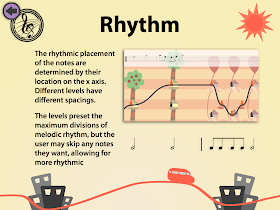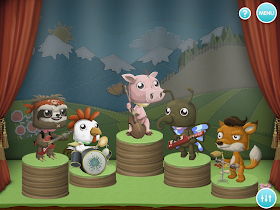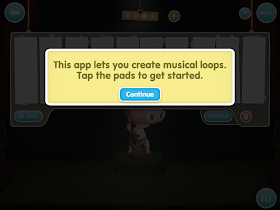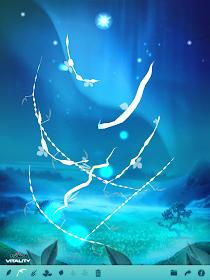Tuesday, November 18, 2014
Turkey, Turkey, Turkey!
Saturday, November 8, 2014
The Classroom Teacher Is Late To Pick Students Up From Specials! Now What?

Saturday, October 18, 2014
Sunday, October 12, 2014
Composition Apps: The Good, The Bad, and The Fun But Not So Educational
 One final thing I really love about this app is that you can choose a style of accompaniment. Each level has a few different options to choose from.
One final thing I really love about this app is that you can choose a style of accompaniment. Each level has a few different options to choose from.
SketchASong
Pros: cross curricular with art, real instrument sounds, wide variety of instruments to choose from, music concepts such as chord progressions and beat placement are apparent
Cons: if students "color" the pictures, it tends to sound like a cacophony of sound rather than a piece of music, no option to export song - only to save in the app
Cost: FREE
This app combines the world of art and music. Students can choose from several coloring pages to color in. Each color represents an instrument family (ex - various shades of green are woodwinds). It might be a good app to use when teaching instrument families. All sounds in the app are recordings of real instruments.
Glitchamphone

Monday, September 22, 2014
Fall is in the Air! Singing Game and Assessment
Fall is certainly in the air here in North Carolina. While the days are still hot and sunny, mornings are crisp and cool. With this in mind, I thought it would be fun to sing about the change in seasons with my kindergartners!
The whole group sings this song while the three students "show off" their fall objects:

I started by asking if someone knew what season is coming up next. A few enthusiastic hands shot up. After we determined the next season is fall, I read a short book about fall. There are so many great options out there!
Next we learned a song/game celebrating fall called "Fall is in the Air!" Students sit in a circle while three chosen students stand in the center of the circle and pick a fall object. I printed out pictures of a scarecrow, pumpkin, squirrel, acorn, pile of leaves, and sun flower. I did not have time to laminate my pictures this time around but will definitely do so in the future!
The whole group sings this song while the three students "show off" their fall objects:
Fall is in the air!
s m s m s
Fall is in the air!
s m s m s
Gather round,
s s m
Let us see!
s s m
What do you have here?
s s m l s
Students in the center of the circle are called on one by one to sing what they have with this response:
I have a _______________.
s m m s-m or just s depending on syllables
The whole group responds immediately after with:
She/he has a ________________.
s m m s-m or just s depending on syllables
This group response is a good sol mi reinforcer.
This group response is a good sol mi reinforcer.
Assessment
I assessed students on their individual response with the following rubric:
4. Sings sol mi pattern in correct key
4. Sings sol mi pattern in correct key
3. Sings sol mi pattern in tune but in a different key
2. Sings but does not sing sol mi pattern
1. Uses speaking voice, even with I sing, you sing prompt
0. Would not attempt to sing, even with I sing, you sing prompt
2. Sings but does not sing sol mi pattern
1. Uses speaking voice, even with I sing, you sing prompt
0. Would not attempt to sing, even with I sing, you sing prompt

Saturday, September 6, 2014
Cross Curricular Music Centers
This week in 2nd grade, we did centers! Students spent about 7-8 minutes are each of the four centers I had set up. I created these centers with the intention of incorporating other subjects.
Music and Math
This station combines rhythm, addition, and composition into one activity. Students started by practicing writing notes. I created a quick practice work sheet for quarter, half, and eighth notes.
Next students became rhythm composers! Students were instructed to write out a four beat rhythm pattern using quarter, eighth, and half notes. They labeled the number of beats each note received and then wrote an addition sentence to double check they had four beats. One student even commented to me, "Hey! This is kind of like what we do in math class."
Music and Math
This station combines rhythm, addition, and composition into one activity. Students started by practicing writing notes. I created a quick practice work sheet for quarter, half, and eighth notes.
Music and Art
I had two music and art stations in this batch of centers. One was color by note. These color by note worksheets are a musical spin on the popular color by number! I made this activity into a coloring contest for students. I plan to feature the best colored owls on my fall bulletin board. If you're interested in the fall color by note worksheets, you can find them here.
The other music and art center was the draw what you hear center. I played two short pieces of music for students over the stereo system. Students used their imagination to draw scenes to match the music. Playing music out loud also helps keep the noise level down at other centers.
Music and Technology
Students at this station used the iPads to create their own compositions by using the free app TuneTrain. Students guide a train through towns to pick up people at their houses. Each person has a specific pitch. The higher the house, the higher the note. The closer together the houses selected, the shorter the rhythm will be. Students can also choose the accompaniment style (examples include pop, classical, R&B, and more) and have the option of viewing their composition notated on staff. Its a great way to get students thinking about basic music theory concepts!
Thursday, August 28, 2014
Monday, August 18, 2014
Using SQUILT in Music Class
SQUILT is one of my students' all time favorite activities. What is SQUILT you ask? SQUILT stands for Super Quiet UnInterrupted Listening Time. During SQUILT time in my classroom, students listen to a piece of music and then imagine a story in their head. It is a great, fun way to introduce classical music to young children. Students do this activity immediately following the Welcome to Music song we sing each week.

I have my students spread out, sit or lay down, and close their eyes. I let them listen to about 2-3 minutes of music and then have them sit back on the carpet. I choose 3-6 students a week to share their stories, depending on how elaborate the stories are. I post the Youtube videos on my website each week so students can share the music and their stories with their parents/guardians!
You don't have to use SQUILT every week though! Use it as a brain break, an extra time activity, or just something fun and different. They can journal, draw/color what they hear, describe music using musical terms, or simply put their heads on their desks, close their eyes, and imagine!
Lastly, here are the musical selections I've used for SQUILT so far:
William Tell Overture Finale, Rossini
Shepherd's Hey, Grainger
Le Vent Dans la Plain, Debussy
Hoe-Down from Rodeo, Copland

Tuesday, August 12, 2014
Teaching Melodic Contour with Debussy and Ribbon Sticks
This week in 1st grade, we learned a bit about melodic contour!
We started by listening to some simple melodies played on the piano. First I played melodies that only went up or down and had students point towards the ceiling or the ground to indicate direction. Then I played melodies that went up and then down or down and then up. Again, I had students point in the directions one after the other.
Next, we took a listen/look to Debussy's First Arabesque:
While we listened, we followed the purple/orange bubbles with our hand/arms for about a minute.
Then we took a look at another video once they got the hang of following the pattern/music. This video was the one we were going to add ribbon sticks too.
We started by listening to some simple melodies played on the piano. First I played melodies that only went up or down and had students point towards the ceiling or the ground to indicate direction. Then I played melodies that went up and then down or down and then up. Again, I had students point in the directions one after the other.
Next, we took a listen/look to Debussy's First Arabesque:
Then we took a look at another video once they got the hang of following the pattern/music. This video was the one we were going to add ribbon sticks too.
Here's the choreography I used:
:06-:16 side figure eighth(infinity sign) in front
:17-:26 large movement side to side over head
:27-:42 center swirls - stir the pot motion
:43-:45 side figure eighth in front
:47-1:05 side to side over head, ending with ribbon falling downward downward
1:06-1:40 hold ribbon and sway to music
1:42-1:51 side figure eighth in front
1:52-2:04
2:05-2:16 small shake side to side over head and bring movement down as melody moves down
2:17-2:26 shake side to side raise with melodic contour
2:17-end shake side to side all the way down
Before teaching the choreography, I had students do similar movements without ribbon sticks. But if you're pressed for time, you could go right to the choreography!
Monday, August 4, 2014
Good King Leopold - Four Voices
Do you love the game Good King Leopold, but wished it had a story to go with it? I sure did but couldn't find anything kid friendly. So I wrote/illustrated(in powerpoint) one!
If you've never heard of the game, here's how to play:

If you've never heard of the game, here's how to play:
Choose one king/queen to sit on a separate “throne.” All other students stand on the other side of
the room and sing:
Good King(Queen) Leopold The king/queen responds:
(sol mi sol-sol-mi) You
must ask again
May we cross your kingdom? (Sol mi sol
sol-mi)
(sol
sol mi la
sol mi) This time use your
________ voice.
(sol sol mi
la sol sol mi)
Student chooses the voice–
whisper, speaking, shouting, singing.
Students repeat “Good King/Queen Leopold,
may we cross your kingdom?” in the voice that was ordered. The king/queen only
grants permission to students when all have complied with the order. When
permission is granted, students cross over the kingdom. I had my students walk from one end of the carpet to the other. A new king/queen is then chosen.
Add a foam crown from Walmart and you're all set!
Not only is this a great way for students to practice their four voices, it's also a great way to individually assess!






























